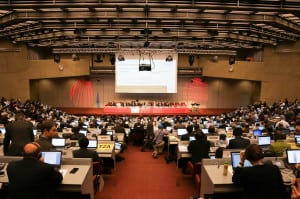Latest News
[Via Satellite 04-03-2015] The International Telecommunications Union (ITU) is preparing for what it expects to be a hotly debated series of issues at the upcoming World Radiocommunications Conference 2015 (WRC-15) this November. More than 100 ITU member states just finished the two-week long Second Session of the Conference Preparatory Meeting (CPM15-2), which culminated in the report to WRC-15. The organization expects and is well aware that conversations centering on the International Mobile Telecommunications (IMT) industry’ spectrum requests will likely dominate the conference.
Chief among these discussions for the satellite industry is whether or not the ITU will decide on a global allocation of some or all of the C-band spectrum, which ranges from 3.4 GHz to 4.2 GHz. Some regions have opted to allocate the lower portion of the band, 3.4 to 3.8 GHz, while others are much more in favor of protecting it as is. François Rancy, chairman of CPM and director of the ITU Radiocommunication Bureau, acknowledged that a compromise similar to what was reached at WRC-07 could happen again this year; namely, “country footnote allocations,” where some nations can decide more specifically on how spectrum should be allocated within their borders. At WRC-07, dozens of nations opted to grant IMT access to 3.4 to 3.6 GHz. The ITU could look to carefully tailor regions where mobile services can have greater access to C band at WRC-15.
“There was a regulatory provision to protect C-band satellite use by applying power limits to transmissions of the mobile service,” Rancy said during an April 2 press briefing. “That’s the regulatory solution that was found at WRC-07. It is obviously one possible option for increasing the allocation to the mobile service at the upcoming conference, or to increase the number of countries, but this, of course, is going to be the subject of difficult discussions.”
Decisions on whether or not a nation prioritized C band for the satellite industry at WRC-07 depended largely on geographic location. C band is less easily attenuated by meteorological activity, thus inclining nations with high rainfall to rely more heavily on it as a source for critical communications. Rancy admitted this could complicate dual-use of the band by both IMT and satellite this time around.
“Obviously there is a difficulty of sharing, and this difficulty is compounded by the fact that in many countries in sub-tropical areas this band is the most appropriate solution to deliver services via satellite. If you go into a higher band, the effect of rain fade on the transmission make them less available to provide critical services,” he said.
Rancy added that the ITU is aware of the argument by the satellite industry that a reallocation of C band could prove, in some ways, detrimental to the IMT industry as well, because C band is used in some places to provide the backhaul infrastructure for mobile services. Preventing this counterintuitive situation is something being considered both now and for the next WRC conference, where spectrum above 6 GHz could also come under consideration.
“This may also be true if you want to do the same exercise at WRC-19 four years from now and explore the possibility of such allocations for the Ku band or Ka band. You will have to take into account the way mobile services as a whole, and not only the part relating to the link between the base stations and the user terminals, but holistically how a global mobile network can build development on a sustainable basis by looking both at the infrastructure and the distribution network,” said Rancy. “It’s a complicated subject and, on this issue, obviously, the CPM doesn’t come with one solution that is agreeable by everybody.” He added that solutions proposed in the CPM range from full allocation of the band to no change at all.
One issue Rancy said the ITU is thoroughly prepared for is the regulatory needs of large-scale constellations such as those proposed by SpaceX, OneWeb and LeoSat.
“We actually went through the whole regulatory exercise on what these types of constellations, what type of challenges they were posing — exactly 20 years ago we started discussing that. It took four conferences: 95, 97, 2000 and 2003, to establish a regulatory environment for this type of system that will protect both in terrestrial services and the other satellite services, namely geostationary satellite services. We are fully ready in the ITU to welcome these types of systems. At the time we had a request for a system of 800 satellites, now we have requests for a few thousands, and the order of magnitude is not very different. I don’t think we need to change the regulations. They are ready,” he said, adding that the ITU has the tools it needs to process the requests.
The ITU is also preparing for significant discussions on spectrum for aircraft tracking. Rancy said the Plenipotentiary requested this and that the ITU has discussed it at length. However, in-depth studies on global flight tracking — which inherently requires satellite — are only in their infancy. Rancy described global flight tracking as “both a difficult and complex issue,” adding that more research will be influential in reaching decisions at WRC-15 this November.
Get the latest Via Satellite news!
Subscribe Now